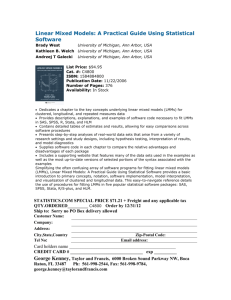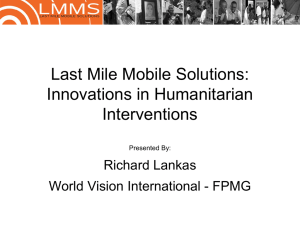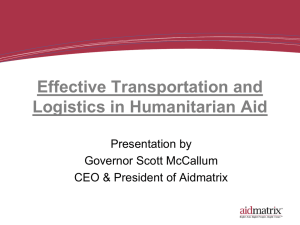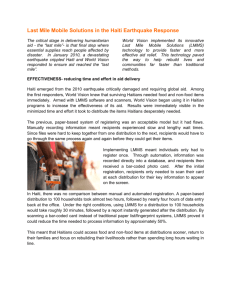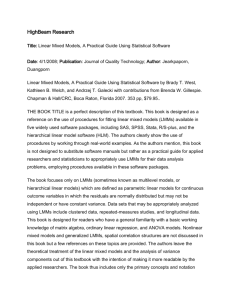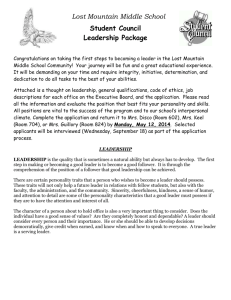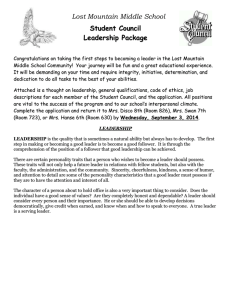here
advertisement
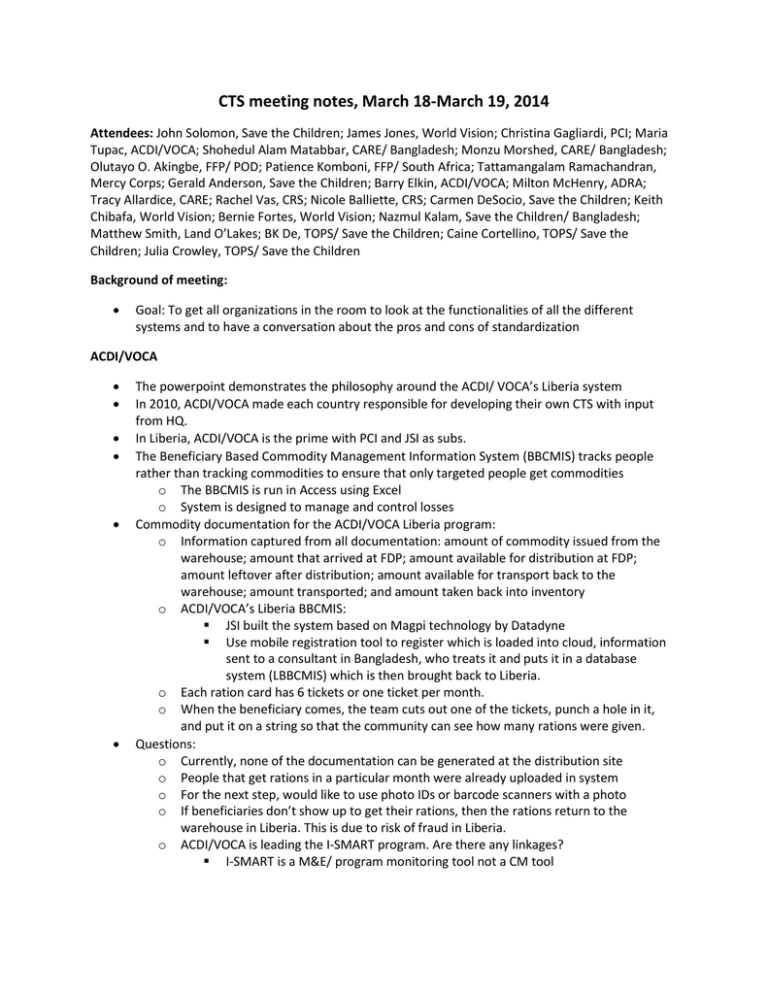
CTS meeting notes, March 18-March 19, 2014 Attendees: John Solomon, Save the Children; James Jones, World Vision; Christina Gagliardi, PCI; Maria Tupac, ACDI/VOCA; Shohedul Alam Matabbar, CARE/ Bangladesh; Monzu Morshed, CARE/ Bangladesh; Olutayo O. Akingbe, FFP/ POD; Patience Komboni, FFP/ South Africa; Tattamangalam Ramachandran, Mercy Corps; Gerald Anderson, Save the Children; Barry Elkin, ACDI/VOCA; Milton McHenry, ADRA; Tracy Allardice, CARE; Rachel Vas, CRS; Nicole Balliette, CRS; Carmen DeSocio, Save the Children; Keith Chibafa, World Vision; Bernie Fortes, World Vision; Nazmul Kalam, Save the Children/ Bangladesh; Matthew Smith, Land O’Lakes; BK De, TOPS/ Save the Children; Caine Cortellino, TOPS/ Save the Children; Julia Crowley, TOPS/ Save the Children Background of meeting: Goal: To get all organizations in the room to look at the functionalities of all the different systems and to have a conversation about the pros and cons of standardization ACDI/VOCA The powerpoint demonstrates the philosophy around the ACDI/ VOCA’s Liberia system In 2010, ACDI/VOCA made each country responsible for developing their own CTS with input from HQ. In Liberia, ACDI/VOCA is the prime with PCI and JSI as subs. The Beneficiary Based Commodity Management Information System (BBCMIS) tracks people rather than tracking commodities to ensure that only targeted people get commodities o The BBCMIS is run in Access using Excel o System is designed to manage and control losses Commodity documentation for the ACDI/VOCA Liberia program: o Information captured from all documentation: amount of commodity issued from the warehouse; amount that arrived at FDP; amount available for distribution at FDP; amount leftover after distribution; amount available for transport back to the warehouse; amount transported; and amount taken back into inventory o ACDI/VOCA’s Liberia BBCMIS: JSI built the system based on Magpi technology by Datadyne Use mobile registration tool to register which is loaded into cloud, information sent to a consultant in Bangladesh, who treats it and puts it in a database system (LBBCMIS) which is then brought back to Liberia. o Each ration card has 6 tickets or one ticket per month. o When the beneficiary comes, the team cuts out one of the tickets, punch a hole in it, and put it on a string so that the community can see how many rations were given. Questions: o Currently, none of the documentation can be generated at the distribution site o People that get rations in a particular month were already uploaded in system o For the next step, would like to use photo IDs or barcode scanners with a photo o If beneficiaries don’t show up to get their rations, then the rations return to the warehouse in Liberia. This is due to risk of fraud in Liberia. o ACDI/VOCA is leading the I-SMART program. Are there any linkages? I-SMART is a M&E/ program monitoring tool not a CM tool o o Currently, there are no protocols in place for exporting data from a country and maintaining privacy. Don’t have the cost breakdown of the system but it is worth it in Liberia ADRA ADRA looking to upgrade the system that they have been using for the last 9 years Access system developed internally based on the Bolivia program Developed the following: warehouse inventories; reports by Bills of Lading; AER balances; preprinted beneficiary signature sheets; distribution waybill amounts; marine survey reports; loss report details; Inland transport Reports; inventory reports by commodities; reports by projects; tracking of beneficiaries; consolidation of multiple warehouses; quarterly reports o The ADRA CTS system on the slides is for HQ with country information uploaded. o If you are at HQ, the first box of “country” is USA because the reports are going to the USA and the project/ country information is in the ‘Whse (Warehouse)’ section so compile data into the ‘USA market warehouse’ to see how much food in total is given What ADRA is looking for in upgrading their system: o Disaggregation of data, eg by commodity, age, gender, activity, fiscal year, cost per kilo o Biometric identification systems o Cloud compatibility o Tie in with M&E systems so that it is one database/ one system Questions: o ADRA’s system is operational in 11 countries, each of which decides whether to use this at the central office or at the warehouse. o What are the biggest weaknesses that make ADRA want to look elsewhere? Beneficiaries aren’t disaggegated, so reporting is more difficult o When ADRA is the prime, do their subs use ADRA’s system? When ADRA is a sub? When ADRA is the prime, ADRA and their subs use ADRA’s system but when ADRA is the sub they use the prime’s system o When ADRA is the subpartner, are training costs included in the budget? Yes, training costs of training ADRA staff on the new system should be included o Is it common, when someone is a sub, that they always use the prime’s CTS system? In DRC, World Vision is a sub to ADRA, but ADRA accepts electronic copies from WV as long as they include the information that ADRA needs in ADRA’s system o How is this supported globally with the cost (maintenance fees, etc)? ADRA IT supports this because Access is well-known. If this was an external product (such as Aidmatrix), budgeting is an issue with some donors. How do you manage this? WFP makes the agency cover the costs although this varies by location Part of the conversation in the annual consultation this year in Rome with the Executive Director is around this issue but no movement yet Mercy Corps Similar tracking system to ACDI/VOCA but are facing problems with losses, particularly from warehouse to distribution Working on developing a system where HQ gets a report every day from the warehouse o Trying to build a system through IT in Portland where they can get the warehouse balances every day through to the HQ level so they know how much food they have o Rest of the systems are at the field, country-level offices Is there a dedicated person to monitor and follow up distribution? o Yes, under procurement, administration, logistic management team developing a program where they can monitor stocks daily in all warehouses o Have food distribution programs in 6-7 countries right now PCI PCI has a .net internet based commodity management system that was developed 3 years ago by programmers in Bolivia o Designed for food and non-food items for Title II and non-Title II o Used in Spanish-speaking countries like Bolivia, Nicaragua o Tracks commodities from order to when they leave the warehouse o In School Feeding programs, PCI can manage each student’s enrollment, attendance and food consumption. Do this through excel spreadsheets and uploaded into the system Challenges: internet based o Warehouse doesn’t have internet Aidmatrix: CARE, Save the Children (SC), CRS Key pieces that exist right now are procurement and warehousing but Aidmatrix does intend to cover the entire supply chain. All part of Aidmatrix SCM4Good Platform: o Currently, the modules on procurement, asset management, warehouse management, reporting, online ordering, and digital hub are in use by some agency/ organization o Future modules either developed or will be developed are planning, fleet management, transportation management, and distribution Currently, the SCM4Good platform can be used to track food from the time we know we have it until when we dispatch out of our warehouse Advantages: Cloud-based system so access to the information to whoever we want to have it Currently, CARE, Save the Children, CRS all using the warehouse module of Aidmatrix Aidmatrix has flex and standard fields, where standard is the same for everyone and flex fields are something that Aidmatrix can customize for particular organizations. Warehouse module o Starts with pre-receipt (inventory that is scheduled to arrive) o Uses a product catalogue with a dropdown menu of food items listed in a standard way so you can roll up data o Receiving inventory where you capture losses by comparing what was received with the waybill. You can also make adjustments based on physical inventory. o Dispatch inventory You can request items to be dispatched and flow through an automated approval process (not required) and once it’s approved, it becomes available for warehouse staff to convert this to an actual dispatch order Pending gaps and pain points o Limited tracking of food beyond warehouse o CSR/ RSR reports lacking o Data relationships: hard to view grouped data outside of certain reports o When CARE started with Aidmatrix 4 years ago, the challenge was to help internationalize a platform used in the US already in emergencies with FEMA o Reaching consensus On the positive side o Goal: CARE, CRS, SC using the same platform in all countries so that data is easily transferrable/ understandable no matter which agency is the prime o Ability to leverage resources. Aidmatrix is a not for profit so they get grants. o Can enter in pre-received information that helps us with planning (eg expected arrival date at the time of pre-receipt) in space and resources o Once we have received the items at the warehouse, program teams have a read-only view and can see the inventory o Track both food and pharmaceuticals Enter expiration date at the time of receipt and the system can give you alerts when the item is about to expire. o The system will generate some of the paperwork (eg dispatch waybill) Questions/ Comments o In the consortium, who pays for the costs of improvement to the Aidmatrix? 3 organizations meet monthly and decide how to prioritize improvements Pick what’s most important to a particular organization and fund that or all chip in if there is something in common. o It is very easy to add gifts in kind to the catalogue. o If you have damaged commodities in the warehouse and you want to send it out for disposal, does it need a dispatch order from the system or is it dealt with separately? CRS has started using the dispatch system but CARE has not Part of the enhancements that CARE has funded dealt with losses o Aidmatrix has an offline component which is a key reason that SC is using this system. This is useful in places with limited or no connectivity. o Is the amount dispatched/ distributed based on the numbers registered in the program? Currently, people select what they want to distribute and when and it shows in the warehouse system. o What are the food-friendly features developed with Aidmatrix? System generated, uneditable numbers for receive and dispatch Receive and dispatch based on waybills so can aggregate at the shipment level Dispatch update which helps us see the amount of food received, distributed and the current inventory at dispatch sites o Haven’t gotten to the point of going after USAID FFP grants o Will Aidmatrix system eventually talk to QWICR system? This is a dream but there are some data security concerns when you start connecting systems. However, looking forward there should be some type of integration such as uploading files to QWICR. o Can Aidmatrix use BUBD (best used by date) instead of expiration date? Expiration date is standard in the system but CRS uses BUBD as one of their flex fields so there is an ability to add that in o o o CARE o o o CRS has BUBD as a flex field because BUBD is used specifically for food. However there are some challenges when the field is a flex field rather than a standard field (can’t get expiration date warning as a pop-up) Accountability Everyone in the system has a unique password and all edits are recorded in the system so you can see who did what and at what time. Is there a notification email that is sent to a designated approval manager that something is waiting for them to approve or do they have to go into the system? When you want an approval flow (primarily in the procurement module), includes an email notification. The approval flow is also included in dispatch order in the warehouse module You can set up alerts within the system, eg if purchase more than $500 or your inventory goes below a certain threshold What about Aidmatrix? Where does the system reside? Is there a monthly fee? Cloud-based (in Microsoft arena). All organizations pay fees for maintenance of the system and the Helpdesk Support function or enhancements. Average fee per year with user fees & maintenance fees. CARE pays a few thousand dollars a month for current active locations How much money would it cost to take Aidmatrix forward? For Aidmatrix to develop distribution and beneficiary registration module, about $120,000-$150,000 at least. Still would be annual fee, system support, training fee Does that change with new agreement with LMMS? (More later in notes) Don’t know the exact cost to integrate either LMMS or aspects of McAID into Aidmatrix. This should be possible but might take time Where is CARE using Aidmatrix? Tested in Sri Lanka, Haiti, Zimbabwe and piloted in Bangladesh in 2011 when it was determined the system was not food-ready Currently using in Zimbabwe and Djibouti Had an implementation of the asset module in Kenya last month Currently using the warehouse component and working on development of the distribution module. Also very interested in the fleet Aidmatrix is a demand-driven system at CARE so it is not required CARE/ Bangladesh’s System Using the system for non-food items and until Aidmatrix can do what CARE/ Bangladesh’s systems can do, it will not be used for food items Using Beneficiary Tracking Systems (BTS) based on Access since 2006, using DTS (distribution tracking Systems) and CAMS Can track all information in Access for each beneficiary. Database links with census data so can easily identify ineligible beneficiaries. Online and off-line components Not everyone has the ability to add information on the server. Generate all information from IPTT from DMS, BTS systems Questions/ Comments CARE is not yet using Aidmatrix in the new Title II program in Haiti. CARE is looking at how to address this as WFP will be handling the logistics. Can Aidmatrix system include home-grown solutions, such as BTS or DTS since the distribution module is not yet developed? Not right now, a list of requirements based on CARE, Save, and CRS’s home-grown solutions has been given to Aidmatrix Need a way for Aidmatrix to connect with external systems CRS o CRS currently using/ tested: Procurement & warehouse, tested fleet and interested in asset and fleet management and distribution o Piloted in Ethiopia, Kenya, West Bank, Burkina Faso o Currently launched 2 new countries (Rwanda, Lesotho) o Planning to do training of trainers to launch regional teams to scale out Aidmatrix but have to work on the system primarily around food. Save the Children o Looking to standardize systems but don’t have the capacity to manage internally o Save the Children starts the cycle in Aidmatrix when they manually enter the call forward from USAID into the pre-receipt o Pilot in Ethiopia: Did procurement, warehousing, reporting on commodities (non-food items) Talking about making distribution and beneficiary validation a priority Goal to finish implementing Aidmatrix in Ethiopia in 2014 o Digital hub: will give ability to do interfacing and there are plans to interface Aidmatrix with Agresso (SCI’s financial system that also does procurement) o Goal: expand to 3-4 more countries per year (procurement, warehousing, reporting) Between 2014-2016, go to 9 more countries Not picked next country yet. Will do so between now and July o Currently, SCI looking at Aidmatrix vs LMMS and selecting a system for distribution o Questions/ comments Aidmatrix can answer how much it would cost to expand to all countries. Does Aidmatrix do any procurement (eg services)? CRS uses it for services. Cost model: It makes sense because there are no license fees although there are service fees negotiated based on number of locations. In addition, Aidmatrix is a nonprofit that can go after additional funding. Save the Children is looking at using the warehouse module for US Programs in a warehouse in Kentucky. McAID (Mother and Child AID System) Overview o Designed, developed, and implemented by Save the Children’s Title II program in Bangladesh, Nobo Jibon o McAID is one platform that includes registration, distribution, and M&E reporting requirements such as IPTT and GIS. o Now is a mobile, web-based software designed to gather and manage data from remote locations using GSM/ CDMA supported mobile handsets or internet modems o Used for both food and non-food items o Tracks performance data, or program activities operating over month/ reporting time o Started in 2005, originally focused on MCHN requirements but expanded to warehouse (2006), livelihoods registration and service requirements (eg FFW) in 2010, GIS , IPTT, and knowledge management feature in 2013 Still working on KM feature o Field-tested and adapted to USAID requirements in Bangladesh o Currently, there are 3 programs using McAID in Bangladesh WorldFish (Feed the Future program) ACDI/VOCA PROSHAR (Title II) Save the Children International (Title II) o Currently using Smart phone (Nokia 5233) Evolution of McAID o Manual Process o PDA/ laptop offline process o Smartphone online process. Still capable of running offline How does McAID work? o www.mcaid.info o By the user ID/ login credentials, the system determines what program he/she belongs to and what access to the data they have o Once you login, system automatically determines what platform you are using If mobile, forms are more user-friendly o Several functional modules: administration, coverage, MIS based GIS, reporting, registration, service, distribution, commodity, staff, KM o MIS based GIS Newly developed, based on USAID policy framework 2011-2015. Highly pushed to integrate GIS features into the system Planning to extend McAID’s GIS system to other Save the Children USAID programs in Bangladesh o Can have data partition where you define which staff can see which parts of the system in the staff section of McAID o Written in English, but because many Smart Phones have other languages, can be translated o Programming language is .net Questions/ comments o If SC has developed McAID that includes distribution, M&E and other components, why are we developing a new system (AidMatrix) rather than scaling up McAID? SC doesn’t intend to hire IT staff to be able to support this. Right now, McAID is funded through USAID and it expires next year SC/ Ethiopia proposed that they use McAID and were turned down because USAID doesn’t want to use a one-off system. CRS went through a similar decision with their Food Log system and were not able to code this Access system into the cloud Might be able to look at applying some of the aspects, such as GIS, barcode scanning, or reporting components, to Aidmatrix or other applications o McAID does not use the cloud o Does McAID incorporate mobile messages to beneficiaries alerting them? McAID: It’s doable but not done yet. In-country infrastructure improved and all beneficiaries have mobile phones. o McAID used in the standard operating system (windows) o o o McAID is scaled up within Bangladesh but can ask why it is not going beyond Bangladesh One module that includes everything (project level, national level) McAID was developed by USAID funds so is accessible by other organizations How much would it cost to scale up McAID other than to Bangladesh programs? What’s needed to get McAID into another country? Country index Implementation costs: eg bandwidth, staff travel Cost of putting McAID into the cloud has not been priced. McAID is easily used for a program although it might be more difficult to include the entire supply chain (eg modules such as fleet management) Can you merge external systems for registration, for example, can you export LMMS data fields into McAID? Data interpreter would be required as can’t translate a form directly into McAID World Vision (WV) 4 different systems that World Vision is currently using: Last Mile Mobile Solutions (LMMS), Commodity Tracking System (CTS), global CTS, and Food Grants Database (FGD) o LMMS and CTS are modular. They are connected but run on different platforms and are for different users. o FGD is an internal WV system and global CTS administers are only WV staff o The global CTS globalizes country CTS data, the summary, RSR, CSR, and disaggregated beneficiary numbers. LMMS o Beneficiary and distribution management module and is community based. o A roaming server based platform that covers an area of a certain number of meters Desktop/ laptop, phone should be in the vicinity Currently working on cloud-based LMMS o Registration done by android smartphone o Developed an offline application o Some of the data that LMMS collects are: Beneficiary details, activities/ materials given to households and beneficiaries, commodity data, system data, location (GPS), warehouses, distribution plans, users, and tracks inventory (both food and non-food) in real-time If you are doing cash for work programs, LMMS also tracks the work where it automatically calculates payment due to beneficiary o Benefits Increases accountability, data can be exported to other systems Very useful if you have monthly, bi-monthly distributions (at least) World Vision has a dedicated unit that does the support, training of LMMS Deploy LMMS globally within WV and other organizations System currently in 2 languages but working to put it in Arabic and Spanish. As you can change languages using Android, this is no longer a high priority CIDA gave funds to provide LMMS for use for other agencies WV is exploring this model for sustainability o Learnings Been deployed for 6 years Some of the paper based requirements from donors (thumb-prints) fallen away. Have personalized brandings within system LMMS gets informed consent from beneficiaries Country level CTS o Data from LMMS aggregated at the country level. o All commodities are tracked by project number because it is linked to budgeting process o Both offline and online o Certification process for CTS Simple user (120 total) and can install system, enter data, and generate reports Advance user (45) can do the same as the simple user but also multiple locations and configure some of the functionalities o 6 different reports that can be generated so can choose what reports you need and choose by period of coverage. WFP forms are embedded in country CTS. o Introducing new modules in CTS, particularly on cash and voucher system o Link between CTS and LMMS Use csv to upload files from LMMS Future goal to put CTS and LMMS in one platform to be able to read directly o Cost and subscription structure competitive $2,500 for a year’s subscription If you use the cloud, it is $200/ month for use of the cloud Global CTS o System Online, public access Can export data and put it in Excel. WFP, USAID, and other users are doing this Only staff of World Vision can be administrators o Information captured includes opening balances for each country, balances, received, distributed, donor balances among others o Accumulated per project and by fiscal year o Uploaded on a monthly basis from country level CTS reports from 1998-2014 o Have about a 2 month lag for inputting data into global CTS Food Grants Database (FGD). o In Lotus Notes o Repository of documents of project from beginning to end o Has a limited numeric functionality Can have percentages of yield (planned vs distribution) Summary tables can include how spent on a particular project by WV US o Can only be accessed by WV staff Questions on country-level CTS, global CTS, FGD, and LMMS: o Is LMMS used for general distribution in emergencies or for targeted feeding? Can you update as children/ mothers graduate from programs? There is a module in LMMS for targeted feeding Doesn’t automatically graduate mother (or child) but there is a way to move person into another category If you want to use LMMS, it would be helpful to sit down with WV to see if LMMS would be a fit for your particular program. o What are the plans/ relationship with LMMS and AidMatrix? LMMS and Aidmatrix signed a Nondisclosure agreement (NDA). The goal is that if LMMS is a fit with AidMatrix and the partners, there would be some interface to take the data between LMMS and Aidmatrix o o o o o o o o o o o o Exact details TBD but potentially looking to have LMMS be the last mile link for Aidmatrix as that is a gap in their system. If LMMS doesn’t fit, Aidmatrix will develop something. In the CARE pilot in Zimbabwe, they will take the warehouse module of Aidmatrix in 1 district and look at how to connect data with LMMS There is a catalogue in LMMS There can be some customer customization in LMMS WV mandated use of LMMS and country level CTS in programs if the program is over 6 months and handles X amount of commodities/ cash. WV charges each project a small amount per transaction and this is due every quarter. WV is looking at applying this business model for other NGOs. How did WV make LMMS mandatory? Each national office has Performance Monitoring Indicators report (PMI) that is 17 indicators, one of which is use of LMMS, and goes to all World Vision offices. If a country scores below 80%, it is outlined in red and head office would call Need to get other stakeholders, particularly audit involved. Programs ending up to two years ago are archived in the Food Grants Database. You can customize the items you want disaggregated in the Country CTS (eg under 2) What’s the next step for World Vision? If you can’t do everything in one platform, at least make everything readable By June, have cloud-based access system QWICR coming on board and pushing on avoiding double data entry. In World Vision’s system, you can see reports by beneficiary and what food/ activities they have received. Use LMMS to register and get muster rolls, absentees. Does this automatically give you distribution orders and waybills? Distribution waybills can be captured by LMMS but are usually captured by CTS. Distribution orders captured through CTS LMMS has not been used for school feeding Difficult to quantify how much each beneficiary receives once have cooked food It is in the pipeline but need to think about how to capture this WV currently captures school feeding activities using paper based and Excel/ access as well as CTS What other challenges with CTS have you faced? CTS developed from scratch, so had many issues over the years, such as being Y2K compliant. Currently using CTS 2013. Had to simplify CTS so all staff and countries could use it Difficult to get the interest of all sectors of WV Mainstream system. Can you merge external systems for registration in LMMS? In Liberia and Niger, working with organizations that have done their registrations on another system and ran a script to upload data into LMMS. You can also easily export a file and upload it in a manner of minutes. Day 2: Standardization Discussion Is there a way in moving forward to a more common system? Do we want to have one system or have the information available to the donor? o System has to be flexible, more complex it is the higher the cost it is to customize it o Combine adaptability of LMMS and report-writing of McAID o Translation Aidmatrix rolled out a French pilot in Chad recently and it was very complex and had to translate both the interface and the data behind it Food Aid Commodity Tracking System (FACTS) o Worked well in the 90s but as people moved on, it stopped o What lessons have we learned from other (failed) commodity tracking systems? First step, large NGOs use a global system Organizational commitment critical Standardization o One system is easy, but so much investment has been put in developing each organization’s system that it might be difficult to do so o In terms of investing resources, how can you collaborate with each other and leverage the resources? o Until supply chain becomes competitive advantage for particular NGOs, sharing is possible but if they were developed using USAID money, the system has to be shared o Need to involve the field staff in the design of systems o Do we want USAID to house this or this to be a USG system? Lose flexibility to make any changes if it’s a USG system Can have different systems that can read / connect to each other Can start with CSV files but maybe there is a better way Can have systems that enable sharing of data sets Particularly useful for longer term development after immediate relief o Still need Standards for Commodity management issued by USAID Leveraging potential o Need a working group to move this forward o Baby steps, can start with being able to upload csv files Scaling up: o Upper level staff and organizational support o Need a system of 24/7 support and prioritizing requests for improvements Working Group o Who should be part of the Working Group? BK will reach out to each organization to see who would like to be in the working group. Once have names, agree on a date of the meeting. ACDI/VOCA, CRS, CARE, TOPS, Land O’Lakes, World Vision interested o Objective of the Working Group is to continue this discussion, whether that be figuring out if we will have one system, or develop a strategy to come up with the data we need to be able to upload to USAID BK to coordinate with Greg on when to involve USAID/POD on this Other things to bring up to donor o Way to upload .csv files to QWICR Separate discussion: how the CM field can adopt technology in their work TOPS has funding opportunities through Small Grants o Can it be used for developing systems? Has to go through technical review at TOPS and approved by FFP so TOPS can’t guarantee funding. So far, USAID funding has not been used to develop Aidmatrix for CRS, Save, or CARE o Aidmatrix is not open-source but organizations interested can talk to Aidmatrix o Aidmatrix open to working with USAID. They could do a presentation to working group. If you are interested in the CM Task Force, let BK know. The next meeting will be on April 29th.
